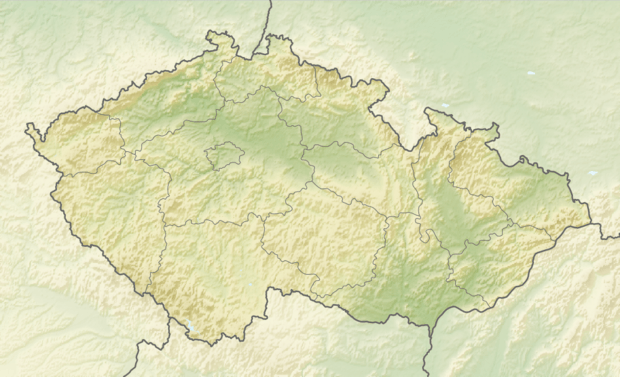Halže
Halže (German: Hals) is a village in the Plzeň Region of the Czech Republic. It lies near the town of Tachov (German: Tachau). It has around 940 inhabitants.
Halže | |
|---|---|
Village | |
Church in the village | |
 Flag  Coat of arms | |
 Halže Location in the Czech Republic | |
| Coordinates: 49°50′4″N 12°34′36″E | |
| Country | Czech Republic |
| Region | Plzeň |
| District | Tachov |
| Municipality | Tachov |
| Area | |
| • Total | 35.56 km2 (13.73 sq mi) |
| Elevation | 596 m (1,955 ft) |
| Population (2011) | |
| • Total | 981 |
| • Density | 28/km2 (71/sq mi) |
| Time zone | UTC+1 (CET) |
| • Summer (DST) | UTC+2 (CEST) |
| Postal code | 347 01 |
| Website | www.halze.cz |
The natural western border is formed by the Bohemian Forest (Český les). Halže is an ideal starting point for trips to the Bohemian Forest and only a few km south-east from spa resort Mariánské Lázně.
History
The first written document mentioning Halže comes from 1479. The church of Halže was built in the years 1799 – 1801.
In the 14th century the district of Tachov comprised over a hundred villages. Several important battles of the Hussite Wars took place throughout the Tachov region. Later the region was under the Habsburg rule since the 16th century. After the death of King Louis II of Hungary and Bohemia in the Battle of Mohács in 1526, Archduke Ferdinand of Austria became King of Bohemia and Bohemia became a constituent state of the Habsburg Monarchy. In 1919, after World War I whole Bohemia became the core of the newly formed country of Czechoslovakia.
The Tachov region fell to Germany in 1938. Following the Munich Agreement in 1938, the border regions of Bohemia inhabited predominantly by ethnic Germans (the Sudetenland) were annexed to Germany; this was the single time in Bohemian history that its territory was divided.
In 1946 most German-speaking inhabitants, the majority in the village Hals and the whole Tachov area, were expelled. After the war the area was only partly repopulated.
After the Velvet Revolution (1989) German companies started to operate factories to make use of the cheap labour in the Tachov area.